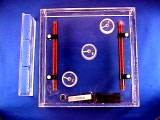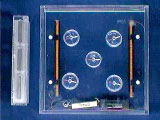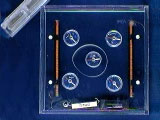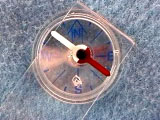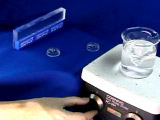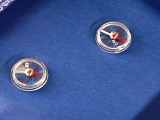
Nuclear Magnetic Resonance
Magnetic nuclei are excited in techniques like Magnetic Resonance Imaging (MRI) and their oscillation frequency depends on the magnetic field. Here compass needles represent the nuclei as they are excited in a magnetic field.
This simulator uses a Plexiglas frame on which are mounted a pair of hand-wound electromagnets (optional), a switch, a resistor and a 9-volt battery holder. The atomic nuclei are represented by orienteering compasses, drained of their fluid and placed on the top surface of the Plexiglas frame. To the side of the simulator is placed a linear array of three strong permanent magnets. For more information see Joel A. Olsen, Karen J. Nordell, Marla A. Chesnik, Clark R. Landis, Arthur B. Ellis, M. S. Rzchowski, S. Michael Condren, George C. Lisensky, "Simple and Inexpensive Classroom Demonstration of Nuclear Magnetic Resonance and Magnetic Resonance Imaging", J. Chem. Ed. 77, 882(2000).
Oscillation frequencies of the compass needles decrease with increasing distance from the magnets on the left. Five compasses are arranged in an "X" pattern. The array of strong permanent magnets is to the left of the compasses at the start of the movie. The electromagnets are pulsed by pushing the button. This causes the compasses to resonate at different frequencies depending on their distance from the permanent magnets. The compasses closest to the permanent magnets resonate at the highest frequency, the compasses furthest resonate at the lowest frequency. Midway through the movie, the permanent magnets are moved parallel to a diagonal, causing those compasses on the parallel diagonal to resonate at the same frequency. Shielding of the magnetic field is demonstrated by placing a ring of metal around one of the compasses. The compass surrounded by the ring now has a lower resonant frequency. When the ring is removed, the compass returns to its original resonance frequency. A magnetized compass needle glued to a piece of clear plastic is placed above an oscillating compass needle. The oscillation frequency decreases. As also shown in this movie, the oscillation frequency increases when the glued compass needle is rotated 180o. This illustrates that two nuclei that are coupled will have their peaks symmetrically split into two peaks in the NMR spectrum, one at higher and one at lower frequency than the frequencies of the uncoupled nuclei. The frequency of an oscillating magnetic field, as provided by a magnetic stirrer, is adjusted and the oscillation of compass needles in a fixed magnetic field goes in and out of resonance. The resonance frequency of the compass depends on the strength of the permanent magnetic field so the two compasses, placed at different distances from the permanent magnet at left, have different resonance frequencies.This page created by George Lisensky, Beloit College. Last modified November 4, 2013 .
